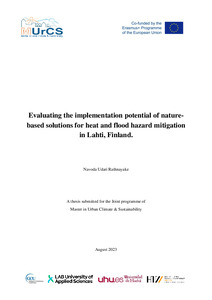Evaluating the implementation potential of nature-based solutions for heat and flood hazard mitigation in Lahti, Finland.
Rathnayake, Navoda Udari (2023)
Rathnayake, Navoda Udari
2023
All rights reserved. This publication is copyrighted. You may download, display and print it for Your own personal use. Commercial use is prohibited.
Julkaisun pysyvä osoite on
https://urn.fi/URN:NBN:fi:amk-2023112531646
https://urn.fi/URN:NBN:fi:amk-2023112531646
Tiivistelmä
Extreme weather events triggered by climate change is affecting urban populations of Europe on multiple forms. Strategies for mitigating heat and flood hazard and facilitating adaptation to inevitable impacts of climate change are therefore being increasingly explored for urban areas. Although relatively new, implementation of nature-based solutions (NbS) is slowly gaining traction as their co-benefits and ecosystem services are being valued alongside their capacity to mitigate heat and flood risks, as well as to build adaptive capacity. However, NbS implementation depends on the mitigation needs, as well as various socio-ecological implications. Therefore this study focuses on exploring the parameters affecting NbS in urban areas, for heat and flood hazard mitigation.
The case-study based research focuses on Lahti, Finland which is a model city representing a medium-sized European city from the continental climate zone. Although an urgent risk seems irrelevant for the city, the heat and flood hazard assessment reveals a need for mitigating urban heat island (UHI) effect and urban flood events, while building adaptive capacity for predicted climate change impacts. Assessment of barriers and opportunities for NbS uptake highlighted the need for integrating combined green and blue infrastructure, to ensure their dual functionality in synergy. These findings were combined with the literature to propose a criteria for selection and implementation of NbS, in urban areas of the city.
The study concludes that NbS can be integrated in Lahti’s built fabric as complementary infrastructure, to help mitigate heat and flood risk. Building knowledge and technical capacity among key stakeholders is crucial, while co-creation with citizens, decentralizing and combining with the city’s planning strategy are identified as the most favourable approaches for facilitating NbS uptake.
The case-study based research focuses on Lahti, Finland which is a model city representing a medium-sized European city from the continental climate zone. Although an urgent risk seems irrelevant for the city, the heat and flood hazard assessment reveals a need for mitigating urban heat island (UHI) effect and urban flood events, while building adaptive capacity for predicted climate change impacts. Assessment of barriers and opportunities for NbS uptake highlighted the need for integrating combined green and blue infrastructure, to ensure their dual functionality in synergy. These findings were combined with the literature to propose a criteria for selection and implementation of NbS, in urban areas of the city.
The study concludes that NbS can be integrated in Lahti’s built fabric as complementary infrastructure, to help mitigate heat and flood risk. Building knowledge and technical capacity among key stakeholders is crucial, while co-creation with citizens, decentralizing and combining with the city’s planning strategy are identified as the most favourable approaches for facilitating NbS uptake.
